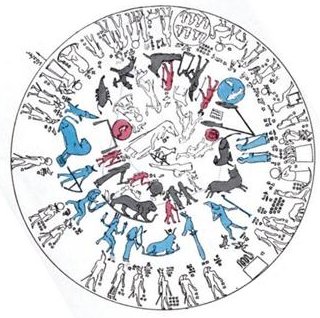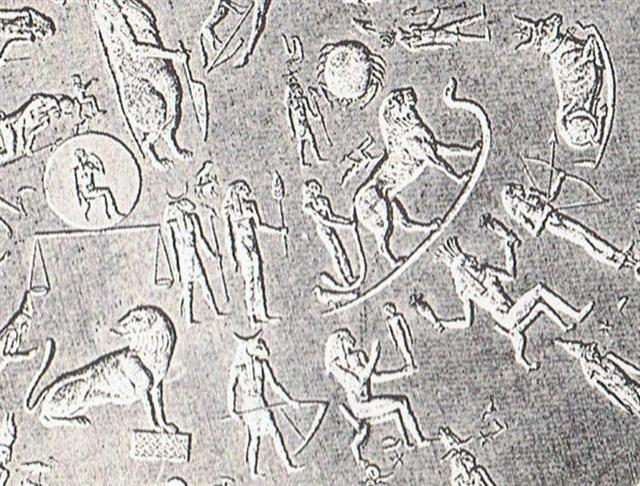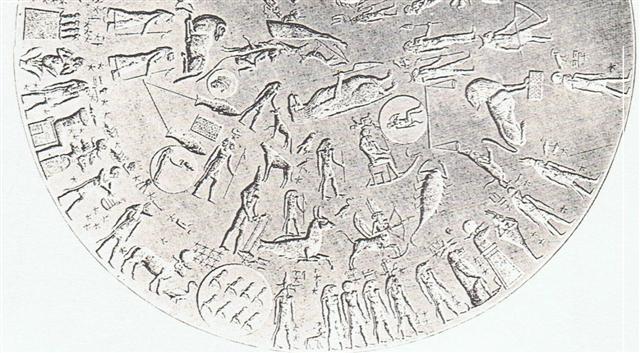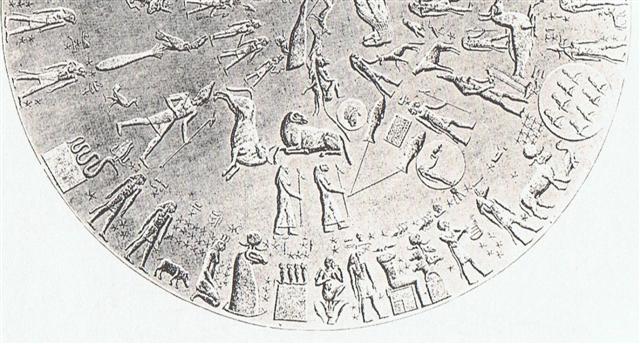|
TRANSLATIONS
Next page:
|
In Kjellson there is a useful picture of the round Dendera
zodiac, because he has coloured its 'glyphs'.

There
are 12 blue figures and Sirius has position 7
counted from left to right. It is the first 'glyph'
in the 2nd half of the blue series. I have oriented
the picture so Sothis will be at the
bottom, corresponding to how deep down from the
celestial equator Sirius is.
12 is
the logical number of figures, because the Egyptians
had defined a calendar with 12 times 3 times 10 =
360 days. Also the black figures are 12 in number.
The red are different, they are 7 and Kjellson
suggests they represent planets.
The
bluemarked zodiac is not our well known one but the
blackmarked we can recognize. The Fishes with a
waterfilled Pegasus Square is at right in the
picture and below them is in order from right to
left: Aries, Taurus, Gemini, Cancer, Leo etc. Maybe
the black zodiac refers to the region north of the
celestial equator ('land') and the blue zodiac to
the 'water' below the celestial equator. Gemini, for
instance, is not far away from the Sothis cow.
The figure carrying a
henen
does not stand at the beginning of the first half of
the blue zodiac, he is number 3. The preceding
figure is a lion sitting down and looking back - his
season is ending. Also the blackmarked Aries ram is
looking back. Maybe this backward looking pair
demarcate the 'winter' half of the year, 5 blue + 7
black figures.
The structure with 2 months ('figures') fetched from the previous 'side' is
what we have found also in the rongorongo texts. In e.g.
G we must add 64 days (2 months à 32 days) to the 'front side
and then tagata toki will be positioned as the henen
figure -
though at the onset of 'land' instead of at the onset of
'water':
 |
 |
 |
|
Ga1-29 (30) |
Ga1-30 |
Ga2-1 |
|
94 |
95 |
96 = 64 + 32 |
96 = 3 * 32 confirms the interpretation of tagata toki in
Ga2-1 initiating 3 * 100 days of Sun. Or maybe we should rather
think in terms of 3 times 150:
|
 |
447 |
 |
 |
 |
 |
 |
|
Ga2-1 |
Eb6-34 |
Eb6-35 |
Eb6-36
(546) |
Eb7-1 |
Eb7-2 |
|
96 |
3 * 150 = 450 |
547 |
3 * 182 + 2 |
6 * 36 =
216 is a reasonable number for the last of the Sun
glyphs. 546 = 3 * 182 and 5 * 46 = 230 (the number
of glyphs on the front side of G).
54 * 6 =
day 324 is also a sign for the end of Sun's rule. The 11th
kuhane station Akahanga comes only ½ day later, and
we have met number 324 several times earlier in this dictionary,
for instance at Gb4-3:
|
207 |
 |
148 |
115 |
 |
|
Gb4-3 (324) |
Ga5-5 (116) |
|
208 = 4 * 52 |
264 = 4 * 66 |
|
472 = 4 * 118 |
324 is
still a day of Sun (he is not yet 'buried') and therefore there are 3
'waves'
on top of the 'staff' at right in Gb4-3 (in contrast
to the 2 waves in Eb7-1).
|

Kjellson
identifies the planets thus: Venus is the person
who stands between Pisces and Aquarius, Mars
is standing on the back of Capricorn, Saturn is
between Libra and Virgo, Mercury between Virgo and
Cancer, and Jupiter between the Leo and Gemini.
The Moon
is also one of these planets, he says, and it is
pictured as a round plate with an eye inscribed
(between Pisces and Aries). The
great planet upon Libra he has not identified, but
we can guess it must be the Sun.
Let us
now scrutinize his identifications. Most promising,
at first, is his statement that Saturn is between
Libra and Virgo. Because we can see that this figure
is right above the ram-headed god which I have
tentatively identified as Khnum, the god of
primary creation. Saturn is connected with the dark
times in which the process of regeneration is hidden
from sight, and Khnum was the 'father of
fathers, and mother of mothers'.
And
certainly, when we look closer we can see that
Kjellson's Saturn is the same person as the one who carries the henen
in the blue zodiac, the 3rd figure among 12:
But
considering the fact that the blackmarked Aries ram
is looking back, shouldn't the standing blue ram be
Mars rather than Saturn?
The
great round plate on the 'beam' (significantly) of
Libra, certainly must be the Sun, here depicted as
a sitting child with hand towards mouth (the Horus
child). Another recognizable sign of the juvenile
Sun is his lock of hair hanging down like an S,
which we can see in for instance this picture (from
Lockyer) of Harpocrates (the Greek name for
Sun at the horizon in the east):
|
If Sun
as a juvenile is balancing on the beam of Libra, and
if a standing Ram god follows immediately to the
right, then the time of the year should be spring
equinox (in the era when Aries had this position):

At this
time of the year digging the earth in order to plant
a new crop should be his habit (Sun in Aries). Libra
is 6 months away from Aries, but south of the
equator it is spring equinox. Khnum was
located far south in Upper Egypt
(where 'up' meant south and 'down' meant north), at
the source of the Nile (not literally of course) from where water flowed.
I.e.,
when Sun was balancing on Libra the flood of water
should begin to flow high up in the southern region
of Egypt. The Ram god should stand in the south, and
for the moment I can see no reason why his representative planet should
not be Mars. Summer was (covered) over north of the equator.
But who
is then standing on the back of Capricorn (if it is
not Mars)?
|
It is
not easy to see who he is, and I wish I had a
picture with higher quality:

Where
'water' is changed into 'land' we can expect the 'tail' of a
creature to be fishlike and its front part to be
mammalian. Such is here the case with the Capricorn
figure.
In other
words, a new 'fire' must dry
away the 'water'. The creator of this source of
light should
be standing on the 'goat-fish', and therefore it
may be Saturn who rules this
sign. Mars will enter 3 quarters later, at Libra, if
we change to the southern perspective.
All
figures are facing forward to the right (exactly as
in the rongorongo texts). Irrespective of
whether a sign is north or south of the celestial
equator it should be drawn facing (wellcoming) the rising Sun in
the east. To do otherwise would be utterly lacking in respect,
you cannot show your rump to the king.
Above is
depicted the winter half of the year, as defined by
a backward looking Aries and a lion who also has
turned his head around - their hind quarters are not
facing the Sun. Aquarius is to the
left of the 'goat-fish'. Pisces with a waterfilled
Pegasus Square
precedes Aquarius. Sagittarius (an archer) and
Scorpio also belong in winter (north of the
equator). South of the equator winter is ending with
some unknown creature holding the tip of the tail of
a backward looking lion (who is the last sign of
southern winter). In contrast the tail of Leo (north
of the equator) is held high up by some other
person.
I at
first accepted Kjellson's identification of Venus
as standing between Pisces and Aquarius. My motive
was that there is a round plate adjoining the
standing Venus figure - Venus has two faces.
However, also
Moon has two faces. Considering the obvious
connection between the two faces of Moon and two
fishes - and if we accept Kjellson's identification
of the small plate as Moon - it is necessary to
identify the other plate (thought to
be Venus) with waning Moon (the fatter phase).
The
standing figure which adjoins the 'fatter' plate is
the one which Kjellson identified as Venus. If
so, then we must - I think - recognize Venus also in
the very large plate in the outer circle,
immediately below Aquarius. It has 8 figures, a
number which associates with Venus (with 8 Earth years
corresponding to 5 Venus years).
|
Astronomical fact is that Mercury must be close to
Sun. Kjellson has located Mercury as the little
figure between Virgo and Cancer:

If we
begin our counting of the solar year with Aquarius, then
the 6th sign will be Cancer. It is therefore quite
in order to find Mercury close to Cancer. A backward
looking serpent is seen on top of his head and
the first half of the year is ending. Mercury is
associated with a serpent (which 'flows' on the
ground like a liquid).
Presumably Cancer represents the old Sun (with head
down and somewhat to the left). On the
other side of Cancer is Jupiter (according to
Kjellson), which we know belongs in next half year.
By locating Mercury close to the old Sun (Cancer)
but anyhow in line with infant Sun, his close
association with Sun is made clear. Therefore
Jupiter should be on the other side of Cancer.
|
If we
orient the picture so that the backward looking Ram
(which is part of our well known northern hemisphere
zodiac) will be in the center as the end of winter, i.e.
moving the dial of time to some 2000 years BC, then
the special attention given to the ram in the outer
circle can be understood:

Only the
front part of this outer circle ram is seen, as if
he was rising up from a hole in the ground. Congruent with
a spring equinox Ram is a winter solstice Aquarius
(2 signs earlier) and a summer solstice Cancer (3
signs later).
The year
therefore seems to end with autumn equinox at Libra, but the
blue southern zodiac intrudes here. New year south
of the equator is the main event, not autumn equinox
north of the equator:
Beyond
Scorpio there are 2 blue signs before the standing ram
god apparently defines the onset of southern spring.
It is similar to how in the north 2 black signs
(Aquarius and Pisces) come before the Ram.
Above
the northern Ram is a strange constellation
difficult to see clearly. But at the bottom of the
long vertical assemblage two 'persons' are drawn
back-to-back, the one at left is standing tall and
the one at right is sitting down. We can also
recognize the famous leg constellation hanging above
the head of the lying down Ram:
|
Next page:
|
In overview we can see that our own (blackmarked) zodiac
describes a circle:

The
bluemarked signs envelop this circle in a formation
like
U, and I think this zodiac refers to the Moon.
Therefore I have rotated the picture so that the
bird perching on top of a kind of pole is at the
bottom. It is sign number 8, with
a further 4 blue signs to the right. The Moon is
governed by Venus, and 8 * 29.5 = 236.
Satit
is not aiming her bow at the Sothis cow but
at the perching bird, which reminds us about
One-Hunaphu (a Mars character) aiming his
blowgun at Seven-Macaw who in his pride
thought he was the Sun:
A man
has a straight weapon, a woman a bent one (as the
Moon crescent). Both these perching birds probably
indicate solstices, One-Hunaphu (Mars, the
spring garment of the Sun) is eliminating the standstill at
winter solstice and Satit the standstill at
summer solstice.
If we
identify his child with the kuhane station
Tama, then the standing ram god should be the
preceding Roto Iri Are, which agrees with
earlier arguments (cfr at hoea):
... The
importance of Roto Iri Are can be quickly
described by pointing to number 13, because even we
in the civilized world understand that sign. It is a
'dark' month. Once there were 13 zodiacal signs, but
one was eliminated - the Serpent (or, more to the
point, Ophiuchus - the 'Snake'-Bearer) ...
Furthermore, the preceding blue lion turning his
head around and 'standing on water' (enclosed in the 'box'
below his front paws) should be at Hatinga Te Kohe
(12 * 29.5 = 354), the obvious final for the rule of Sun. The
straight beam above in Libra is intact but south of
the equator it is being broken. We can say that the
rule of Sun is being transferred from the southern
hemisphere to the northern.
But
already at Akahanga (11 * 29.5 = 324½) Sun
has disappeared from view, as we know. The first of the
bluemarked 'stations' is a figure with a tall
conical 'hat'. Probably it signifies how the 'head'
is hidden and it has become dark. Such a conical hat
is also Aquarius wearing. It is a fool's cap,
suitable for someone in a dark corner.
In Gb8-1
the sign with double heads (kea) apparently corresponds to the tagata rere
posture of Anuket as waning moon. Crustaceous
creatures (kea, Cancer, Scorpio) signify
'old'. For instance is Scorpio the last (the 12th)
'station' counted counterclockwise from
'Harpocrates' (balancing on the straight beam of
Libra).
Beyond One Tea lies (according to Manuscript
E) Hanga Takaure, the 'Bay of Flies' (souls
of the dead). 16 * 29.5 = 472 and we have arrived at puo
in Gb8-30.
A month is used in order to 'ignite a new fire'. The reversed manu rere
(Gb8-5) is exceptional in turning his face
to the left, away from the rising Sun. The reason is
that he is the rising Sun. When the Sun
spirit (manu rere) is returning to earth
again it can be expressed by a reversed manu rere. The journey
will then go upwards from sea-level to the height of
Poike.
Satit stands (so to say) at
Hanga Takaure and she points her arrow upwards.
The Sothis cow is uplifed into the sky like
the souls of the dead (the 'flies'). If Leo in his
boat is the spirit of the dead Sun - having spent
his 300 days - then Sothis ought to be the
spirit of the dead Moon. The 17th station of the
kuhane must be the beginning of a new season, 17
* 29.5 = 501½. Maybe the Sothic cycle is alluded to,
because 1460 * 365¼ = 533265 days = 17 * 31368.53
where 313-68-53 is an interesting number sequence.
We
must end here before we loose control in this
complicated game. But let us do so by looking at an
interesting myth about another lady archer.
|
|
"A
man had a daughter who possessed a wonderful bow and
arrow, with which she was able to bring down everything
she wanted. But she was lazy and was constantly
sleeping. At this her father was angry and said: 'Do not
be always sleeping, but take thy bow and shoot at the
navel of the ocean, so that we may get fire.'
The
navel of the ocean was a vast whirlpool in which sticks
for making fire by friction were drifting about. At that
time men were still without fire. Now the maiden seized
her bow, shot into the navel of the ocean, and the
material for fire-rubbing sprang ashore.
Then the
old man was glad. He kindled a large fire, and as he
wanted to keep it to himself, he built a house with a
door which snapped up and down like jaws and killed
everybody that wanted to get in. But the people knew
that he was in possession of fire, and the stag
determined to steal it for them. He took resinous wood,
split it and stuck the splinters in his hair. Then he
lashed two boats together, covered them with planks,
danced and sang on them, and so he came to the old man's
house. He sang: 'O, I go and will fetch the fire.' The
old man's daughter heard him singing, and said to her
father: 'O, let the stranger come into the house; he
sings and dances so beautifully.'
The stag
landed and drew near the door, singing and dancing, and
at the same time sprang to the door and made as if he
wanted to enter the house. Then the door snapped to,
without however touching him. But while it was again
opening, he sprang quickly into the house. Here he
seated himself at the fire, as if he wanted to dry
himself, and continued singing. At the same time he let
his head bend forward over the fire, so that he became
quite sooty, and at last the splinters in his hair took
fire. Then he sprang out, ran off and brought the fire
to the people."
(From the Catlo'Itq
in British Columbia according to Hamlet's Mill.) |
|